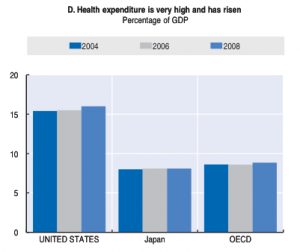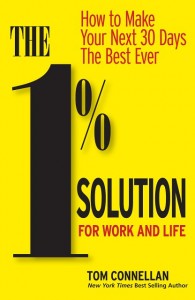Posted by Elena del Valle on April 11, 2011

Health care expenditure comparisons – click to enlarge
Graphs: Organization for Economic Co-operation and Development (OECD)
A new Organization for Economic Co-operation and Development (OECD) 227-page report, Economic Policy Reforms Going for Growth, highlights issues relating to growth among member, and some non member countries. The report outlines salient issues and suggested recommendations for individual countries including the United States. While the organization’s researchers concluded our GDP (gross domestic product) is one of the highest among OECD members thanks to high labor productivity they found relative labor utilization had dropped. They noted the benefits of recent health care and financial sector changes while calling for additional changes they believe to be necessary especially in education, health care and tax reform.
The first priority the analysts drew attention to was education, explaining that in spite of high per pupil spending United States student scores were below the OECD average in the international student test (PISA). The report calls for an improvement in teacher education and development in order to increase student achievement; and suggests the United States make schools accountable for student progress. In light of the 2010 Census numbers that point to minority markets as the main source of demographic growth in the country the importance of education among minority students is likely waxing.

Secondary education performance comparison – click to enlarge
Health care expenses are already high and continue rising at a steady pace, according to the report released last week. The researchers concluded that while last year’s health care reform law reduced long term expenditures it is unclear how it will affect health care. They recommend the adoption of Medicare provider reforms after pilot testing; and that the health tax exclusion (i.e. the exclusion from taxable income and payroll tax of compensation in the form of health insurance cover) be limited beyond what was planned to reduce incentives for people to buy health plans with little cost sharing.
The report recommends the United States broaden the tax base by “reducing the value of the mortgage-interest deduction on owner-occupied housing and limiting the health tax exclusion.” The analysts also think a move away from personal income towards consumption-based taxes such as a VAT is worth pursuing. Other recommendations included the reduction of agricultural subsidies and the adoption of policies that promote social mobility.
The OECD, about to turn 50, provides a forum for member governments to compare policy experiences, “seek answers to common problems, identify good practice and coordinate domestic and international policies.”
Posted by Elena del Valle on April 8, 2011

Johnny Depp and Penelope Cruz in Pirates of the Caribbean: On Stranger Tides
Photos: Disney Enterprises, Inc., Peter Mountain
Disney, Jerry Bruckheimer and Johnny Depp are at it again. Next month a fourth Pirates of the Caribbean movie will hit theaters nationwide. This time Penélope Cruz, the increasingly popular Spanish actress has joined the infamous pirate troublemakers. Click below to see two videos in English with previews of the film Pirates of the Caribbean: On Stranger Tides.

Pirates of the Caribbean 2011 poster in Spanish

Johnny Depp as Captain Jack Sparrow
The skull often seen representing The Pirates of the Caribbean franchise was transformed for the latest film to include a mysterious X scar on the left side of the face, new beads, a pearl in the gold front tooth, blond streaks in the hair, skeletons hanging from the last trinket on the beaded dreadlock, a hidden Mickey on the left dreadlock and swimming mermaids engraved on the hand guard of the right sword.

Pirates of the Caribbean – click to enlarge
The Skull features the red bandana Captain Jack Sparrow wore in all the films of the Pirates of the Caribbean series. According to promotional materials red was a popular color with pirates, who preferred more colorful dress; it was also a color synonymous with “giving no quarter.”
The crossed swords, or pirates’ cutlasses, purportedly have a special meaning: When the crossed swords face upward, they indicate readiness for battle. When the swords point downward, they signify the end of conflict. Down-pointing crossed swords are a common military symbol on graves or memorials signifying death in battle. On the teaser poster the swords are pointing downward.
Posted by Elena del Valle on April 6, 2011
Information provided by Event Partner

Hispanic Reach 2011
The Premier Hispanic Marketing Executive Summit
June 22-23, 2011
Crowne Plaza Dallas Downtown, Dallas, TX
Hispanic MPR subscribers qualify for a special discount for Hispanic Reach 2011.
Welcome to Hispanic Reach 2011, an informative and interactive conference featuring some of the leading brands and marketers in Hispanic business today. This event takes place in Dallas June 22-23.
In light of the 2010 census results, it’s become even clearer that the U.S. Hispanic community continues to expand at an astronomical rate. 2011 is expected to be a breakout year as Hispanic marketing matures across all digital marketing platforms including social, mobile and search. Now is the time for corporations to execute innovative marketing strategies to endure and flourish in this era of Hispanic expansion.
Featured Speakers:
Mark Lopez
US Head of Hispanics
Google
Carla Dodds
Director of Multicultural Marketing
Wal-Mart
Charles Garcia
CEO
Garcia Trujillo
Raymond Arroyo
Chief Diversity Officer
Aetna
Alex Lopez Negrete
CEO
Lopez Negrete
Rochelle Newman-Carrasco
Chief Hispanic Marketing Strategist
Walton | Isaacson
Details and registration are at www.worldrg.com/hispanicreach. Hispanic MPR subscribers should enter the Promo Code “QTJ984” for $200 off the registration rate. To register, please call 800-647-7600 or register online at www.worldrg.com/hispanicreach. For sponsorship opportunities contact Mark Coulter, 646-723-8049, mark.coulter@worldrg.com.
Posted by Elena del Valle on April 4, 2011

Lucia Navarro, co-anchor, Café CNN
Photos: CNN en Español
As part of a comprehensive slate of changes that began late last year, CNN en Español expanded its programming in March 2011 with the launch of three new shows, Café CNN, CNN Dinero and Conclusiones. The new shows bring the total number of new programs on air to ten. The other seven programs are Showbiz, Mirador Mundial, Notimujer, Cala, Panorama, Documentales and Choque de Opiniones.

Carlos Montero, co-anchor, Café CNN
Café CNN, a three hour program that airs weekdays between 6 a.m. and 9 a.m. (ET), was designed to blend hard news with human interest and lifestyle improvement information to help viewers “stay ahead in today’s competitive world.” It is hosted by Carlos Montero, a CNN en Español anchor, and Lucia Navarro and Alejandra Oraa, two journalists making their CNN en Español debut on the show.
CNN Dinero, a one-hour show about finance, economy and money issues hosted by Gabriela Frías and Xavier Serbia, who will make his official debut as a full-time anchor, airs weeknights from 8 p.m. to 9 p.m. (ET). Frías returns an hour later with co-anchor Fernando del Rincón, in Conclusiones at 10 p.m. (ET) featuring key events of the day, analysis, and news headlines.

Gabriela Frías and Xavier Serbia, co-anchors, CNN Dinero
A native of Buenos Aires, Argentina Montero joined the network in 1997. Prior to working at CNN es Español he was host of Buenos Días América and América Noticias in Argentina. He also worked as a reporter and producer in the news department at Univision in Miami.

Alejandra Orra, co-anchor, Café CNN
Oraa, a native of Venezuela, has a bachelor’s degree from Saint Thomas University. She started her career at the age of 18 working as a correspondent and creative producer for TV Azteca in Miami. In 2009, Oraa worked as a radio personality for Romance 106.7 FM, a Miami radio station, where she hosted the show Paparazzi Radio Sensacional along with Fernando del Rincón. In late 2009, Oraa joined the team of television network Mega TV as a producer and on-air talent for the newscast Mega News.
A native of Monterrey, Mexico, Navarro received her degree in Communications from the Instituto Tecnológico y de Estudios Superiores de Monterrey (ITESM). Her career began in 1984 in Monterrey with her debut as morning anchor for Al Aire on TV Azteca. She has won three Emmys for Investigative Reporting, and for insightful reports in the categories of Medical and Social Issues and in the Hard News. In addition, she has won two Golden Mike awards as Anchor of the Best Newscast: Telemundo 52 and for Best Breaking News coverage.

Fernando del Rincón, co-anchor, Conclusiones
Frías joined the network in early 2000 as a producer for Economía y Finanzas, CNN en Español’s former prime time business news program. As the show’s producer, Frías was responsible for the overall creation of the daily newscast, selecting the show’s content and guests, and participating in the writing, research and editing of news stories. She also served as a substitute anchor for the program. Before joining CNN en Español, Frías worked as a business reporter for Reforma in Mexico.
Serbia is author of two books, La Riqueza en Cuatro Pisos, published in 2009, and Pregúntale a Xavier, published this year. Since 2006 he has been a contributor to Yahoo Finanzas en Español. His column has been published in El Nuevo Día de Puerto Rico and El Diario La Prensa.
Del Rincón, a resident of Miami, Florida, was born and raised in Yautepec, Mexico where he started his communications, television and radio career at the age of 16. Most recently, he was on the air six days a week as the host of Primer Impacto and Ver Para Creer on Univision.
CNN en Español, CNN’s independently produced 14-year old network in Spanish, provides 24-hour news coverage of major world events, live breaking coverage, business and financial news, weather updates, sports and feature programming on health, technology and entertainment. It is currently available in 25 million cable and DTH households throughout Latin America, and 5 million households in the United States.
Comments:
Filed Under: Media
Posted by Elena del Valle on April 1, 2011

The Facebook Marketing Book book cover
Photo: O’Reilly Media
So Facebook has become large, really large. From a business perspective what does that mean? Can Facebook help you promote your brand, products, and services? While an increasing number of users become frustrated with the social media site’s fluid privacy policies others wonder if the return on investment in time and human resources are worth the effort.
Dan Zarrella, an inbound marketing manager at HubSpot, and his wife Alison Zarrella, a copywriter and social media consultant, believe the popular site can be a useful marketing business tool. They share their ideas on the subject in The Facebook Marketing Book (O’Reilly, $19.99) a newly published book.
“Facebook is today what websites were 10 years ago, it’s a relatively ‘new’ thing, but your customers expect you to be there, and your competitors know this. To younger generations, it’s especially odd to see a company not using Facebook. In short, you can’t afford not to be on it,” said Alison Zarrella, coauthor with her husband, Dan. “After reading this book, readers will have a clear map of what they can do on Facebook and where to start. They’ll know what they can do on their own, and what they might need a little help with.”
The 272-page softcover book features introductions to Profiles, Groups, Pages, Applications, Ads, Events, and Facebook etiquette. It is divided into twelve chapters.
The authors promise readers clear, actionable items to deal with Facebook, information to understand the social networking world, information on technologies necessary to take advantage of social network marketing, possible tactics to use on Facebook and its features, tips on setting campaign goals and learning which Facebook features may be useful to marketing campaigns, and ways to measure campaign results.
Dan Zarrella has written about the science of viral marketing, memetics (an information pattern) and social media on his and other blogs. He was awarded Shorty and Semmy awards for social media and viral marketing. In her work Alison Zarrella has consulted for Holiday Inn, InterContinental Hotels Group, Tide, Always, GMAC Mortgage, General Motors, Samsung, Buick and GMC Sierra.

Click to buy The Facebook Marketing Book
Comments:
Filed Under: Books
Posted by Elena del Valle on March 25, 2011

The difference between a winner and a loser is sometimes minuscule. Often those in the lead are only 1 percent better than the next person, according to Tom Connellan, a public speaker and author. To illustrate he points to Olympic games participants. He says an Olympic gold medal winner is only slightly faster than the athlete in the fourth place without any medal recognition; one percent faster, he says.
In The 1% Solution for Work and Life How to Make Your Next 30 Days The Best Ever (Peak Performance Press, $19.95), Connellan discusses the difference an improvement or advantage of even a very small percent can make in the success of athletes, executives, and students. He believes the leverage power of that 1 percent can make a huge difference in the results.
He admits in the book that not everyone is likely to be great but insists that everyone “can be better than they are right now.” He also believes that accomplishing something motivates people to accomplish something else. Setting clear goals, taking action (even small steps are okay), and focusing on effectiveness and efficiency are some of the ways to strive for the one percent improvement he discusses in the book.

Tom Connellan
He is convinced that small changes in actions may lead to large changes in results. Emphasizing maximum performance in the present; monitoring results and comparing yourself only to yourself are useful ways to improve, according to him.
Additional suggestions include regular vacations, working in periods of concentration and recovery, building breaks during a work period, napping during the day and sleeping eight hours a day.
The 154-page hardcover book published early this year is divided into seven chapters: It’s Turning Point Time!; The Upside-Down Way to Boost Your Motivation; The Physics of Personal Success: How to Create a More Powerful You; Why Practice Doesn’t Make Perfect, and What to Do About It; The 30-Day Formula That Will Change Your Life; How Not Doing Anything Helps You Get More Done; and The Circle is Complete.
Connellan founded a service company and built it into a network of 1,200 instructors serving 300 hospitals and many of the Fortune 500 companies. He is the author of ten book.
Click to buy

The 1% Solution for Work and Life
Comments:
Filed Under: Books
Posted by Elena del Valle on March 18, 2011

Be Your Own Brand book cover
Photos: Berrett-Koehler Publishers, Inc.
David McNally, a film producer and author, and Karl D. Speak, a brand building consultant and author believe everyone has a personal brand. They think of it as the way that other people perceive who a person is and what he or she stands for. Building a personal brand, they say, is about understanding who someone is and wants to be, and identifying the right way to share that impression with others in a genuine way.
The best way to do that, according to them, is to “make a positive difference in the lives of others.” In 2002 they published the first edition of Be Your Own Brand, a book about personal branding. In Be Your Own Brand Achieve More of What You Want by Being More of Who You Are Second Edition (Berret-Koehler Publishers, $19.95) published this year, they share their original ideas on personal brand building and expand on the changes that have taken place since they published the first edition.
They are convinced that the concept of a personal brand has become more accepted in the business environment; and that social media is playing a role in facilitating the development of personal brands. The idea behind a personal brand is to create a brand that is distinctive, of interest to others and “consistent in the way it is perceived and presented,” they say.

Karl Speak
According to the authors, someone with a strong personal brand uses his or her qualities to make a difference in other people’s lives. The 143-page softcover book is divided into ten chapters and three main sections: Personal Brand Basics, Designing Your Personal Brand of Making a Difference, and Using the Power of Alignment to Build a Strong Personal Brand.
McNally’s books and films have been translated to twelve languages and been available in twenty countries. Speak founded Brand Tool Box Ltd., an internal branding company, in 1984.

Click to buy Be Your Own Brand
Comments:
Filed Under: Books
Posted by Elena del Valle on March 11, 2011

Enchantment book cover
Photos: Guy Kawasaki
Why do people of all ages stand in line and wait with anticipation to purchase new Apple products like the iPhone, iPod, iPad? Then, a few months later return to buy the newest version of the same product? Why did mobile services provider T-Mobile recently loose more than 300,000 customers many of which are thought to have become AT&T and Verizon customers to get their hands on the iPhone? Guy Kawasaki, a former Apple executive, believes it is the result of something he calls Enchantment.
This month, he explains what he believes makes people, brands and products desirable in Enchantment The Art of Changing Hearts, Minds, and Actions (Portfolio/Penguin Group, $26.95), his new 211-page hardcover book. He believes this quality of Enchantment transforms relationships and situations, converts hostility into civility and civility into affinity, converting skeptics into believers without manipulation.
He proposes an attitude that drives voluntary, lasting and happy (he calls it delightful) change in others by focusing on people’s wants, being likable and trustworthy and representing a worthy cause. At the end of each chapter, he showcases an example written by a guest contributor to illustrate the point he wrote about in that chapter.
The book, peppered with how-to tips, is divided into an Introduction and Conclusion as twelve other chapters: Why Enchantment?, How to Achieve Likability, How to Achieve Trustworthiness, How to Prepare, How to Launch, How to Overcome Resistance, How to Make Enchantment Endure, How to Use Push Technology, How to Use Pull Technology, How to Enchant Your Employees, How to Enchant Your Boss, and How to Resist Enchantment.

Guy Kawasaki, author, Enchantment
He urges those who enchant to do so responsibly so that their skills benefit all involved. To make Enchantment last he thinks it is necessary to present an idea that other can internalize allowing them to reciprocate and fulfill their commitment. He also suggests relying on a network of supporters among developers, consultants and cause friendly people.
Kawasaki, the author of nine previous books, is co-founder of Alltop and founding partner at Garage Technology Ventures.

Click to buy Enchantment
Comments:
Filed Under: Books
Posted by Elena del Valle on March 9, 2011
By Patria de Lancer Julnes, Ph.D.

Patria de Lancer Julnes, Ph.D.
According to 2009 census estimates Hispanics1 comprise the largest minority group among, 15.8% or 48.4 million people and expected to continue growing. In spite of the size and rapid growth of the Hispanic population, for a long time Hispanics have been considered a sleeping giant, a label that, according to Cristina Beltran (2010), evokes the notion that Hispanics are “subjects on the cusp of political power and influence” (p. 3), but also a group who is “politically passive and difficult to mobilize: the giant who cannot be roused from its slumber” (p.4).
However, in a recent book, journalist Jorge Ramos (2005) challenges the image of Hispanics as a sleeping giant, arguing that Hispanics not only are now able to decide closely contested electoral races, but also that because of their size, important decisions will require the support of Hispanics. Ramos predicts that the “Hispanic vote will cease to be a weightless player on the political scale, and instead become the veritable ‘big boy’ in states and regions where the Latino vote has historically congregated” (p. xviii).The results of the 2010 midterm election, when for the first time three Hispanic candidates won top state level posts, seem to confirm Ramo’s predictions.
Click here to read To awake sleeping giants, invite them to play for real

































